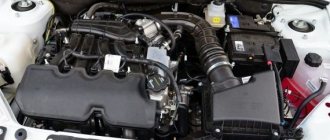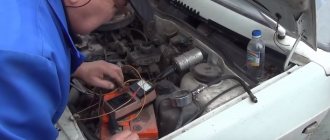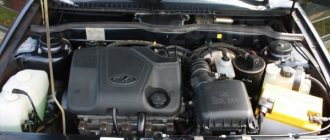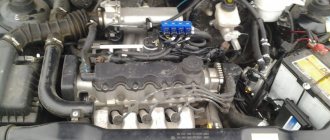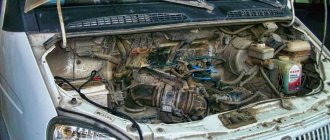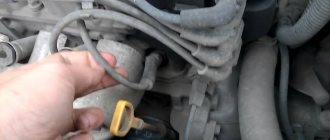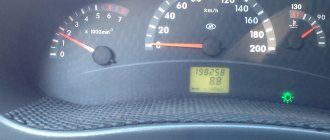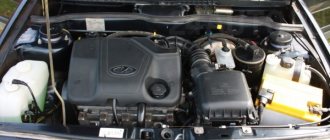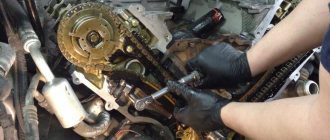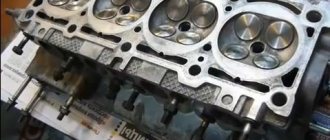For example, the Toyota Land Cruiser 200 SUV is equipped with an eight-cylinder power unit. Depending on the number of problem cylinders, this engine can have “seven” or “six”, and so on. However, they still say that “the engine started to misfire.” The Oka has a two-cylinder engine, which means that in case of problems it will be “alone”, but out of habit they talk about tripling.
Now four-cylinder engines are installed en masse in VAZ and GAZ cars. Everything matches here. When they say that a Gazelle engine is tripping, it means that three out of four cylinders are functioning. It’s the same with Ladas – the name of the fault can be taken literally.
Signs of a problem
When the engine starts to stall, the driver feels it based on a number of signs:
- strong vibration at idle,
- drop in engine power,
- Difficulty starting a cold engine.
If you experience any of these symptoms, there is likely a problem with one of your vehicle's cylinders. Or the problem is general, but in one cylinder it manifests itself clearly. What to do in such cases? Let's figure out why the engine is tripping, then it will become clear how to deal with this malfunction.
Let’s be clear right away - the engine can stall when cold, at idle, or in any operating mode. Why might a cylinder refuse to work? In fact, there are only three options: either there is nothing to burn, or there is nothing to ignite (for gasoline internal combustion engines), or there is not enough oxidizer (low compression). Therefore, when the engine stalls, the reasons must be sought either in the fuel supply, or in the generation of a spark, or in low compression (especially for diesel engines).
If the engine starts to stall, you should immediately troubleshoot the problem. Otherwise, you will get accelerated engine wear, increased fuel consumption and the possibility of a major accident at any time. This is due to the fact that fuel may continue to flow into the idle cylinder. It washes away the oil from the walls of this cylinder and dilutes the oil in the crankcase, which leads to increased wear, scuffing, and in extreme cases, an explosion of fuel vapors can occur.
Engine diagnostics
First you need to find the non-functioning cylinder. There is a simple and clear way for gasoline engines. At idle speed, it is necessary to disconnect the high voltage wires one by one, supplying a discharge to the spark plug. When the electrical supply is cut off at the working cylinder, the engine starts to rev harder. If the non-working one is turned off, there will be no changes in the operation of the motor. Care should be taken to avoid receiving a harmless but painful electric shock.
When the VAZ direct injection injector of the engine is damaged, the search for a non-functioning cylinder is simplified. There is no need to climb into the wires and risk getting an electric shock. It is enough to turn off the control of the injectors one by one. You also need to find a cylinder that, when turned off, does not change the behavior of the power unit.
When diagnosing a diesel engine, you need to turn off the fuel supply one by one. For example, you can simply unscrew the fuel line nuts. The goal is the same - to find a cylinder, when turned off, the engine runs without changes.
Motor tripping: air supply problems
Inadequate or excessive intake air can also cause cylinder misfire. The air supply system may lose its tightness and the engine begins to suck in excess air. The ECU does not take this leak into account, and as a result, the stability of operation is disrupted.
Checking the air system is quite simple. It is necessary to tightly close the inlet pipe next to the air filter, then pump air to create a pressure of about ½ atmosphere, and then look for the leak. If the pressure does not drop, then the system is sealed. The appearance of a hissing sound of escaping air allows you to determine the problem area through which the motor is sucking in excess.
Lack of air often occurs due to a dirty air filter that has lost its capacity. The filter must be removed and the engine performance assessed after removal. There may also be insufficient air if the throttle valve is clogged or there is a problem with this unit. This element requires mandatory cleaning and inspection. It is advisable to do this at every scheduled maintenance in parallel with replacing engine oil, filters, etc.
Another reason for engine stalling may be the throttle position sensor, mass air flow sensor, or other sensor that sends an incorrect signal to the ECU. In such a situation, the control unit does not know to what degree the damper is actually open, how much air actually entered the engine, etc. Based on incorrect data, the “brains” cannot accurately calculate the optimal composition of the fuel-air mixture in relation to the dynamically changing operating modes of the internal combustion engine.
In this case, you should view the sensor readings and read the errors using a scanner that is connected to the vehicle’s diagnostic connector. Then the values must be compared with the nominal ones. Deviations from the norm in the readings of the air flow meter or throttle position sensor lead to the engine starting to stall.
Finding the reason
Having found out which cylinder is causing the engine of a VAZ or a car of another brand to fail, we proceed to further research. You need to remove the spark plug and inspect it for the presence of gasoline. If the contacts are wet, it means either there is no spark, or the mixture is excessively rich or, on the contrary, lean.
If the candle is to blame
Install a known good spark plug and check the operation of the cylinder. If it starts working, you need to change the spark plug; if it doesn’t work, then the reason why the engine is throbbing is something else. We continue to search.
Problems with wiring or ignition distributor
The next thing to look at when there is no spark is the high voltage wiring. It is necessary to check the condition of the contacts and insulation. Are the terminals intact, free of corrosion, and is the insulation free of cracks? So the problem is elsewhere. Is there any damage? Replace the cable and check the performance of the spark plug again.
There is an express way to check high-voltage wires. It is necessary to start the engine, which has started to stall, in the dark - at night or in a windowless box with the lights off. Under such conditions, all breakdowns will be clearly visible in the form of sparks. With such a malfunction, the voltage simply does not reach the spark plug, so it does not spark.
If the wiring is OK, inspect the distributor cap. Due to a malfunction of this device, different cylinders work intermittently in turn. Cracks on the cover are a clear sign that one of the contacts in the ignition distributor has burnt out, so the engine began to stall.
Air intake from outside
If the spark plug is working properly and the discharge is supplied to it as normal, then the problem is in the air-fuel mixture. Sometimes the intake of air from outside dilutes the injection of gasoline to a concentration at which the mixture does not ignite.
The reasons for air getting into the cylinder can be very different: from damage to the intake manifold pipe to depressurization of the cylinder head seals. This is manifested by the fact that the engine stalls at speed and stalls when the load increases.
To fix the problem, you need to replace the damaged duct or seals. It is possible that air is leaking through the cylinder head gasket. You can replace the gasket yourself or contact a specialist.
Insufficient compression
Sometimes compression in the combustion chamber does not reach the desired value due to loss of tightness. If the mixture is not compressed to the desired level, the concentration of gasoline vapor is insufficient to ignite. Often the cause is stuck piston rings.
Due to accumulated deposits, the rings “stick” to the piston grooves and do not provide proper tightness. During the compression stroke, the air-fuel mixture seeps through the gaps of the piston-cylinder pair. Compression drops, fuel does not ignite.
In diesel engines, fuel spontaneously ignites due to high temperature when air is compressed. And if the compression is insufficient, then there will be no ignition. The quality of fuel atomization is also important here. If the high pressure fuel pump or injectors do not meet the specified parameters, then the fuel will not be evenly distributed in the combustion chamber in thin droplets, but will be “poured” or injected in large droplets. Such a spray of fuel, even with good compression, can lead to cylinder failure.
If the air duct is in good condition, but signs of malfunction have recently appeared, use Suprotec Active Plus tribological compound. It is added to motor oil. In terms of its mode of action, it is an engine additive; it does not change the composition of the lubricant and does not react with its components.
Engine oil additive "Suprotek Active Plus"
Restores compression, reduces fuel consumption and oil waste, reduces wear rate and extends the life of internal combustion engines of any type. Facilitates cold starts and protects against overheating in traffic jams.
more reviews
The Suprotek Active Plus product improves the operation of valves and the oil pump by removing contaminants from friction pairs. The product also restores worn parts of the cylinder-piston group at a microscopic level. The tribo composition is capable of decoking stuck piston rings if the case is not completely advanced.
This set of factors helps restore compression in the combustion chamber to nominal values. The gaps in the friction pairs are normalized, and a thicker film of lubricant is retained on the parts. The cylinder operation returns to normal.
Of course, in advanced cases, when there is already wear on the inner surface of the cylinder, the additive will not help. This problem can only be solved by overhauling the engine with boring the cylinder and installing oversize pistons or lining.
To maintain in good condition and restore the characteristics of the fuel equipment of a diesel engine, it is recommended to use the Suprotek TNVD fuel additive.
Fuel additive "Suprotek TNVD"
Additive for high-pressure fuel pumps of diesel engines of any design (in-line, distribution, main in Common rail systems)
more reviews
Suprotek MAX injection pump additive for trucks
For injection pumps of diesel internal combustion engines of trucks and special equipment: in-line, distribution, main fuel pumps, COMMON RAIL systems, PUMP-NOZZLE systems.
more reviews
Reasons: why the engine troits
Increased engine vibration occurs due to a violation of mixture formation. This leads to additional loads on the parts of the cylinder-piston and crank system, and therefore reduces their service life. Main reasons:
- fuel is supplied in a larger or smaller volume. With a larger volume of gasoline, the spark is not able to ignite the mixture fully, so when you press the accelerator pedal, the car begins to twitch, and the fuel continues to burn in the exhaust line. If there is a lack of fuel, the engine behaves the same way, but this can lead to burnout of the piston due to insufficient cooling from gasoline injection.
- lack of oxygen. The power unit behaves the same as when there is a lack of fuel. Air deficiency can be caused by a dirty air filter or a faulty oxygen sensor.
- The ignition system is not working correctly. The reasons lie in the setting of the ignition angle, where the spark may be supplied too early or late, and accordingly the mixture again burns incompletely. If the coil and spark plug are faulty, they also contribute to tripping. On carburetor engines with a distributor, the ignition angle often gets lost, which requires periodic adjustment.
- low compression. For this reason, complete combustion of the working mixture is impossible due to a violation of the cylinder seal. In this case, tripping is accompanied throughout the entire engine speed range, sometimes it may not appear until the engine reaches operating temperature.
Thus, the reason for the engine tripping lies in problems with the ignition system, fuel and intake systems. This most rarely occurs through a decrease in compression (at high mileage), which occurs due to an increase in the gap between the cylinder and the piston or due to burnout of the gas distribution valve.
Spark plugs are to blame
The first thing you should pay attention to is the condition of the spark plugs. The cause of tripping may be hidden in an incorrect gap between the electrodes, or in a breakdown of the spark plug. If adjusting the gap and cleaning from carbon deposits does not help, you should replace the spark plugs with new ones with the appropriate characteristics. It is recommended to change spark plugs every 20-30 thousand km.
Inspection of high-voltage wires
High-voltage ignition system wires are used on carburetor and injection units (with a single ignition coil). It is recommended to change BB wires every 50,000 km, as they are vulnerable to external aggressive environments. Wiring faults causing motor tripping:
- breakdown of the wire (in the dark a spark is visible from the broken surface of the wire),
- wear of rubber tips,
- The difference in resistance between the wires is above 4 kOhm.
Checking the wires is carried out with a multimeter: set the resistance value in kOhms, clamp the wire on both sides with probes. Normal resistance is 5 kOhm.
Air supply problems
Often the culprit for unstable operation of the internal combustion engine lies in the intake system. The injector is more vulnerable to the problem since the oxygen supply is scanned and regulated by sensors. List of possible faults:
- dirty throttle valve (the geometry of the air flow and its quantity are disrupted),
- the air filter is clogged,
- malfunction of the mass air flow sensor (mass air flow sensor) or the absolute pressure sensor and the intake temperature sensor (DBP + DTV),
- failure of the lambda probe (oxygen sensor),
- air leakage from the intake tract.
Any of the above breakdowns provokes a violation of mixture formation,
Malfunction of injectors and injector
Fuel injector failure is determined by mileage and fuel quality. List of possible faults:
- interruptions in the operation of the engine control unit,
- clogging of the nozzle (throughput decreases),
- a break in the electrical circuit with one of the injectors,
- strong fluctuations in pressure in the fuel rail,
- injector leaking.
To diagnose the injector fuel system, it is enough to “read” the ECU with a scanner for errors. If none are found, you need to wash the injectors with a special liquid, calibrate the throughput, replace the sealing collars, and at the same time change the fuel filter.
When an injection engine fails
It is much more difficult to determine the cause of the malfunction if the engine with an injector is malfunctioning. Power units of this type are equipped with electronic systems that the uninitiated should not meddle with. The maximum that can be done is to check the condition of the spark plugs and injectors.
We have already covered how to check the ignition. With injectors the algorithm is approximately the same. We replace the nozzle of the non-working cylinder with a known good one. If it works, great.
For example, often due to this malfunction, the Kalina engine, a generally unpretentious power unit, fails. Replacing the injectors helps solve the problem. However, it is better not to bring the engine to this state. At the first sign of leakage, add SGA flush from Suprotec to the gas tank.
Detergent additive for gasoline "SGA (SGA)"
Cleans and lubricates fuel pumps and injectors, extends their service life. Improves injection, which reduces fuel consumption and increases dynamics. Suitable for any petrol systems, including TFSI, TSI, GDI, MDI.
more reviews
This mild additive flushes the injectors and protects them from corrosion and wear. The product also improves the operation of the fuel pump, valves and other moving parts of the fuel supply system. When used systematically, flushing "Suprotek SGA" significantly increases engine life.
If even after washing the check light is on, the engine is running, and no improvements are noticeable, then the nozzle already requires replacement. No additive will help, you need to change the nozzle. This is more expensive and takes more time than pouring an additive into the gas tank, so we recommend systematically engaging in prevention.
If the engine stalls when cold
It happens that the engine stalls when cold only in wet weather. Having warmed up to normal temperature, the engine begins to operate normally. This is a clear sign that the insulation of one of the high-voltage wires is damaged. Due to dampness, electricity breaks through to the ground, the candle cannot produce a spark. When the engine warms up and dries, the leak bridge disappears and the engine runs normally. There is only one solution - change the high voltage wires. How to determine which of them is damaged was discussed above.
Why does the engine start to stall?
So, what is the reason for the tripping of a modern gasoline engine with a distributed fuel injection system?
Let's start with the fact that engine tripping is a violation of the combustion of the mixture in the cylinders, which is accompanied by a clear increase in vibration. Please note that the appearance of internal combustion engine vibrations is not necessarily a tripping, since there are a number of other reasons why the engine vibrates strongly.
The list of main faults that cause the engine to stall includes:
- supply of insufficient or excess fuel to the cylinder;
- supply of insufficient or excess air;
- malfunction of the ignition system, early or late ignition;
- wear or breakdown of the motor, which is accompanied by a decrease in compression;
In other words, the engine begins to stall as a result of an inappropriate composition of the fuel-air mixture, untimely ignition of the mixture or inability to ignite the charge, as well as violation of the conditions for normal combustion of the mixture as a result of mechanical wear or breakdown of the engine itself.
Based on this data, you can narrow your search and the number of systems for diagnosis. The check should begin with the fuel system and injector, then the intake air supply and the ignition system are checked. In some cases, engine tripping may also be the result of a failure of one of the sensors in the electronic engine control system.
Fuel system of a car with a gasoline engine
The most common reason that causes the engine to misfire is late or early ignition, as well as a weak spark plug. At the initial stage, you should unscrew the spark plugs for a detailed inspection. If damage to the insulator or other defects is noticeable, then the spark plug should be replaced.
In the case of a damaged insulator, the place of damage is clearly visible, since this area turns black. You should also pay attention to the condition of the central electrode and evaluate the gap of the side electrode.
Next you need to check the spark plug wires. An indirect sign indicating this element is the occasional tripping of the engine in conditions of high humidity (rain, dampness, etc.). After the engine warms up and reaches operating temperature, the symptoms may disappear completely.
You should start by inspecting the spark plug cap and the highest voltage wire. These elements have rubber insulation, which tends to dry out and crack over time, as a result of which the wire begins to break through.
Also, the high-voltage wire or cap is often damaged during service or repair work in the engine compartment. Let us add that the location of the breakdown may not be visually detectable. In this case, it is better to check this element of the ignition system using one of the available methods.
If everything is in order with the spark plugs and wires, then the ignition coil may be the culprit for the engine misfiring. On engines with separate coils for each spark plug, this phenomenon is especially widespread. To check the ignition coil, you need to unscrew the spark plug, apply it to ground and start the engine. Please note that the thread of the candle must tightly touch the mass, the cap must be tightly placed on the candle. Ignoring these rules may result in burnout of the coil or commutator. A good spark with a characteristic crackling sound will indicate the serviceability of the coil; the absence of a spark will indicate the need to replace the coil.
As for the electronic ignition distributor (switch), this element does not break down often. To check, the spark plugs are securely attached to ground, then the caps are connected to them, after which one person turns the engine with the starter, and the other evaluates the strength of the spark on the spark plugs.
If the engine stalls at idle
Are there any special reasons when the engine idles at idle? More likely no than yes. At idle, the engine may stall for any of the reasons discussed in this article. It makes no difference whether the problem is with a Peugeot, Kalina or a car of another brand. The algorithm for finding the causes of the malfunction is the same. If the engine revs only at low speeds, then a slight burnout of the valve is possible. At high speeds, the mixture or air does not have time to pass through the burnout, compression rises and the cylinder begins to work. This diagnosis is verified by examining the exhaust pipe. If oil flies out of it, then the valve is definitely burned out.
Causes of malfunction
It is necessary to understand that if the engine stalls when cold, then most often its incorrect operation is caused by one of the following problems:
- no fuel mixture enters the combustion chamber;
- There is nothing to ignite the fuel.
In both cases, similar symptoms are observed.
However, these are not all the reasons why the car’s power unit fails, since the problem in question is not always a cylinder malfunction. Thus, today vehicles are equipped with diesel and injection engines equipped with many sensors, control units and other electronic components, damage to which can provoke a similar effect.
For this reason, owners of high-tech vehicles need to entrust the search for the reasons why their car is shaking to experienced service station specialists, which is especially important in relation to expensive foreign cars of the latest generations.
A car engine can stall not only in cold conditions, but in various operating modes, which can be assessed by the decrease in power that drops at speed (including idle), during the warming up of the unit and after that. The moment when disturbances in the operation of the power plant are observed must be tracked, and only then the cause-and-effect relationships must be determined.
Situations often arise when the causes of tripping are very trivial, such as a dirty air filter.

